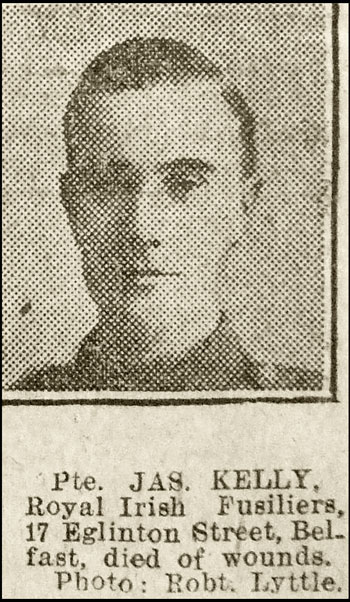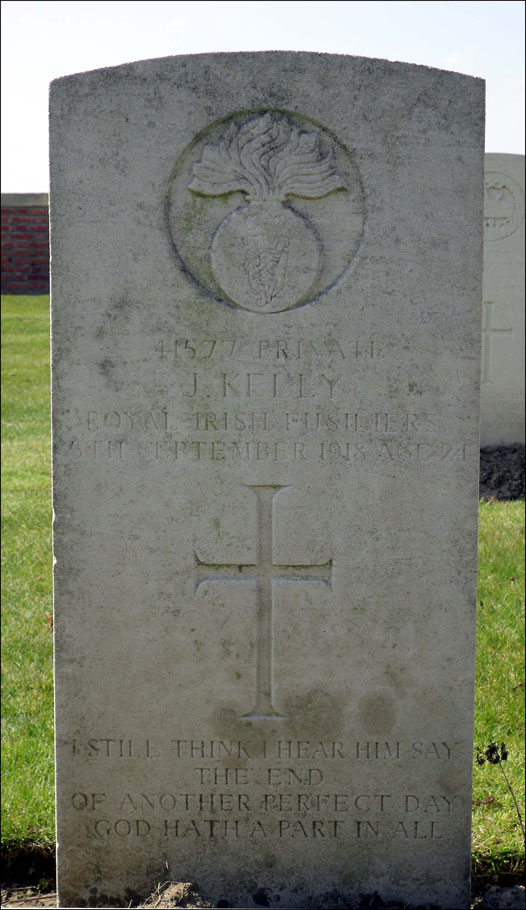![]() In memoriam
In memoriam ![]()
Private James Kelly

James Kelly was born on 5 May 1894 at 27 Lawry Street, Belfast, the first of three children of gasfitter and tinsmith Sampson Kelly and his wife Ellen (nee Boal). By 1911 he was living with his family at 87 Dover Street, Belfast, and working as a linen apprentice.
Kelly enlisted in the North Irish Horse at Belfast on 8 February 1915 (No.1444). He embarked for France on 17 November that year with F Squadron.
In June 1916 F Squadron came together with C Squadron and the 6th (Inniskilling) Dragoons Service Squadron to form the 2nd North Irish Horse Regiment, serving as corps cavalry to X Corps. In August 1917 orders came that the regiment would be dismounted and its men transferred to the infantry. Kelly was one of 70 men given the job of conducting the regiment's horses to Egypt. They embarked from Marseilles on board HMT Bohemian on 25 August. After a month at Alexandria they returned to France, via Italy. On 5 October 1917 they arrived at the 36th (Ulster) Division Infantry Base Depot at Harfleur for infantry training. After just a few days they were posted to the 9th (Service) Battalion, Royal Irish Fusiliers – renamed the 9th (North Irish Horse) Battalion – joining it in the field at Ruyaulcourt on 12 October. Kelly was issued regimental number 41577.
Kelly saw action with the battalion during the Battle of Cambrai in November and December 1917. On 14 December he was sent to a field hospital suffering from trench fever. Twelve days later he was evacuated to England, where he remained in hospital until 15 January 1918. He rejoined the 9th Battalion at Siege Camp on the Ypres front on 22 April.
On 4 September 1918 the 9th Battalion took part in an attack south of Wulverghem on the Ypres front. The battalion war diary for the day recorded the action as follows:
8 a.m. Battle. H.Q. was formed at T.10.d.05.80. and under an artillery barrage the battalion, in conjunction with other battalions on flanks, attacked. Good progress was made. 'D' Coy lost direction and got as far as Stinking Farm (U.7.a). Not being protected on flanks the enemy attempted to cut them off and the Coy had to retire. Our line was established from road (T.6.d.35.80) where touch was made with the 30th Div., along hedge running south through T.6.d.4.0 to river in T.12.b then along breastwork trench from T.12.c.50.35 – T.18.a.80.90, with the gap between 'B' and 'A' Coys. D Coy was put in support along road running south through T.6.c and T.12.a. The enemy were not very numerous but their m.g. fire was heavy. The shelling was fairly heavy but was confined to vicinity of St Quentin Cabaret. During the operation Battle H.Q. was moved to T.5.d.80.40. Six prisoners were made, four of whom were sent through 29th Div. on the right. Some of our men on the right were cut off and are thought to be made prisoners. The 29th Div. took Hill 63 but did not come up far enough to cover our right flank. During the day there was an amount of sniping and m.g. fire and the enemy shelled St Quentin Cabaret and T.12.a with 5.9. In the afternoon he attempted a counter-attack by coming up along railway between 'B' and 'A' Coy. but was driven back by m.g. and rifle fire. At dusk our patrols were pushed forward to get the line behind Bristol Castle but were unable to do so owing to m.g.
The 9th Battalion casualties for the day were four officers wounded, and 17 other ranks killed, 67 wounded and 11 missing. Private Kelly was one of those wounded, having suffered a gunshot wound to his left leg and a fractured right leg. He was evacuated to No.62 Casualty Clearing Station at Arneke but died there on 5 September.
Private Kelly is buried at Arneke British Cemetery, Nord, France, grave III.D.28. His gravestone inscription reads:
41577 PRIVATE
J. KELLY
ROYAL IRISH FUSILIERS
5TH SEPTEMBER 1918 AGE 24
I STILL THINK I HEAR HIM SAY
THE END
OF ANOTHER PERFECT DAY
GOD HATH A PART IN ALL
Gravestone image kindly provided by Richard Evans. See his website Nelson, Glamorgan and the Great War http://www.nelson-ww1-memorial.org.uk. Newspaper image from the Belfast Evening Telegraph kindly provided by Nigel Henderson, Researcher at History Hub Ulster (www.greatwarbelfastclippings.com).

